
The world of food pairings can easily seem overwhelming at times. Some of us know a few traditional rules but feel out of our depth beyond that. We’re here to help with a food pairing guide that can help you create the perfect menu for your next meal, and not just for meat. We’re looking at the best pairings for salads, cheeses, desserts and more.
There’s no need to limit yourself to our specific recommendations, either. We’ll discuss some general principles to help guide you so you’re not afraid to experiment a bit and find some unique combinations you love.
Principles of Flavor Pairing
You may think of flavor and taste as pretty subjective experiences, especially when it comes to pairing. After all, you may love the combination of peanut butter and jelly while your friend can’t live without peanut butter and mayonnaise sandwiches. While the way we experience flavors and tastes is somewhat subjective, it turns out there is a science behind flavor pairing that transcends individuals.
However, research shows that different parts of the world approach flavor pairing differently. Western cuisines generally include ingredients that share a lot of the same flavor compounds, while East Asian cuisines do just the opposite. We’re going to take some time to explain the concept of flavor and taste and focus on the Western concept of pairing like compounds for a meal.

Flavor vs. Taste
First, let’s define flavor and taste, both of which play into food pairings. Flavor refers to the mix of compounds and aromas present in a dish, such as vanilla, spearmint, raspberry and more. Taste is a bit broader. It refers to the general taste qualities we experience with different foods and drinks. The five basic tastes our tongues are most sensitive to are sweet, sour, salty, bitter and umami — or savory. These aren’t the only tastes experts have identified. Other common tastes that come up in food pairing include fat and spice.
You’ll see both flavor and taste come into play when pairing foods or food and drinks. While flavor compounds and the sensation of taste can be scientifically studied, remember, there is a subjective element to the way we experience food and drinks. So, while you can use guiding principles of pairing to attempt to balance and complement your food and drinks, the way you experience this combination is ultimately up to your own taste buds and preferences.
Finding the Perfect Relationship
Since we experience flavor and taste subjectively, there is also a subjective element to pairing food and drinks. If a guide tells you a combination should be perfect, but you don’t enjoy it, don’t force it. And, likewise, if you think an unusual combination is delicious, then simply enjoy it! However, if you’re creating a menu for guests, you’ll want to consider more universal principles to guide your pairings so your guests will all be delighted by the way the flavors interact and bring out the best in one another.
It may sound like we’re talking about a relationship between people, and that is a fitting metaphor. We tend to enjoy the company of people who we have a lot in common with and who are just different enough to make things interesting and challenge us to be our best selves. A perfect relationship between food and drink looks much like that.
To find the best drink to pair with dinner, look for a drink that shares some similar descriptions as the food, as well as some contrasting notes that will make your palate sing. A pairing that is focused more on similarities between the food and drink is known as a congruent pairing, and a pairing that is based more on contrast is known as a complementary pairing.

Food Pairing With Wine
Any sommelier can attest to the fact that wine pairing is both a science and an art. There are guiding principles that can help you choose the best wine to go with an appetizer, meal or dessert. Still, the perfect pairing is ultimately one that you find delicious, so don’t be afraid to experiment a bit. We’re going to look at some basic types of dishes and offer our recommendations for some great wine pairings that will have your guests enjoying every sip and bite they take.
Salad
A salad can be a refreshing start to a meal, but it can be tricky to choose a wine that pairs well with this course. The strongest flavor in a salad is typically the dressing, so the qualities of the dressing are the main guiding factors for picking a perfect white wine. For a creamy salad dressing, choose a creamier wine, like Chardonnay. For tart vinaigrettes, look for a wine that is stringent enough to match or exceed the intensity of the dressing, such as Sauvignon Blanc or an Albariño.
Pork
Pork tends to be a fairly mild meat that pairs well with many wines. Some of the best wines to pair with pork include medium-bodied wines like Zinfandel and slightly lighter red wines like Freisa and Pinot Noir. Ham is a bit different from pork roasts and chops since it tends to combine rich saltiness with sweetness, one of the reasons it’s a favorite main course at holiday dinners. Zinfandel is also a great wine to pair with ham, and other options to consider include sweet, fruity wines like Moscato and Rosé.
Poultry
Poultry is a versatile meat and so are its pairing possibilities. You aren’t in much danger of picking a wine that will clash with chicken, turkey or other poultry, but there are some ways you can narrow in on the best choice. Pay attention to the seasonings or sauces included in the dish. For example, a roast chicken that is seasoned with rosemary calls for Italian reds such as Chianti. If you’re serving only white meat, you may be better off with white wine, while dark poultry meat is best served with a red.
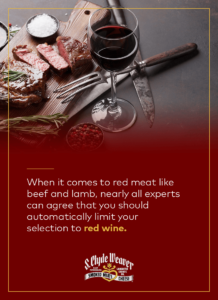
Beef and Lamb
When it comes to red meat like beef and lamb, nearly all experts can agree that you should automatically limit your selection to red wine. A rich beef roast or a steak, for example, tastes fantastic with a Bordeaux, Bordeaux-style blend or a California Cabernet Sauvignon. More delicate reds, such as Spanish Rioja or Merlot, tend to be better choices for lamb. As we’ve discussed with other dishes, remember to pay attention to seasonings and sauces to help guide you, as well.
Fish
Just as people believe red meat calls for red wine, another “rule” that most people accept is that fish calls for white wine. A dry white like Sauvignon Blanc or Pinot Grigio tends to be ideal for mild white fish dishes, such as baked or broiled flounder or tilapia. For fish dishes that are seasoned more heavily, let the seasonings guide your choice in wine, but you’ll still want to focus on white wine options. For fried fish, you may want to consider a complementary pairing like Moscato that will cut through the saltiness with some sweetness and acidity.
Shellfish
In general, acidic white wines that work well for fish also tend to work well with shellfish. Again, though, it’s important to consider the sauces and unique flavors present in the particular dish you’re pairing with. Lobster served with a butter sauce pairs well with a light Burgundy wine. Riesling tends to be a good choice for crab and shrimp. For clams and oysters, which tend to have a stronger flavor than many other shellfish types, you can’t go wrong with a Sauvignon Blanc or Rosé.
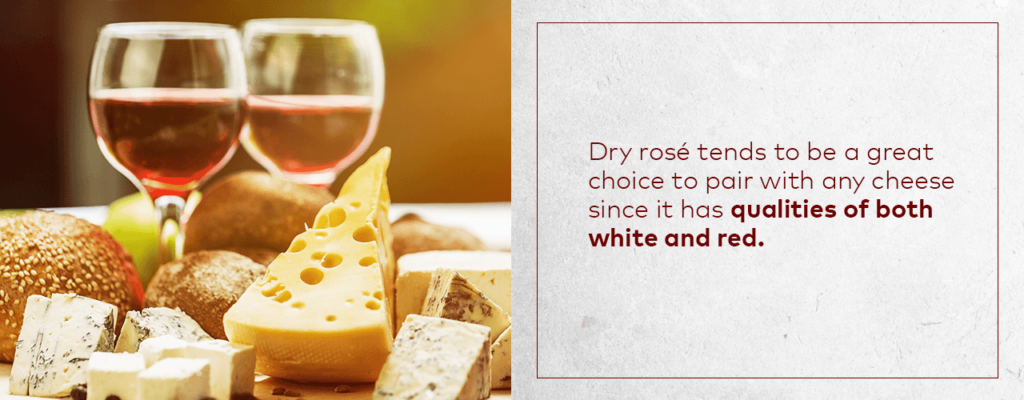
Cheese
Cheeseboards, baked brie, linguini alfredo and other cheesy temptations cry out for a glass of wine. Cheese tends to be rich, so the acidity of wine can round out a cheesy meal perfectly. Because wine and cheese are culinary soulmates, you can find pairing recommendations for nearly any kind of cheese. Some cheeses, like brie, pair best with white wine while others, liked aged cheddar or smoked gouda, pair better with red. Dry rosé tends to be a great choice to pair with any cheese since it has qualities of both white and red.
Spicy Dishes
Spicy dishes bring an intensity of flavor to the table that your wine will need to match. Otherwise, the wine will be completely overshadowed by the food. One strategy is to look for red wines like Syrah or Xinomavro that have spicy notes to create a congruent pairing. You can also consider a low-alcohol wine that offers some sweetness to balance the spiciness a bit. Just make sure it has enough acidity to match the spicy food’s intensity. A good example is Riesling.
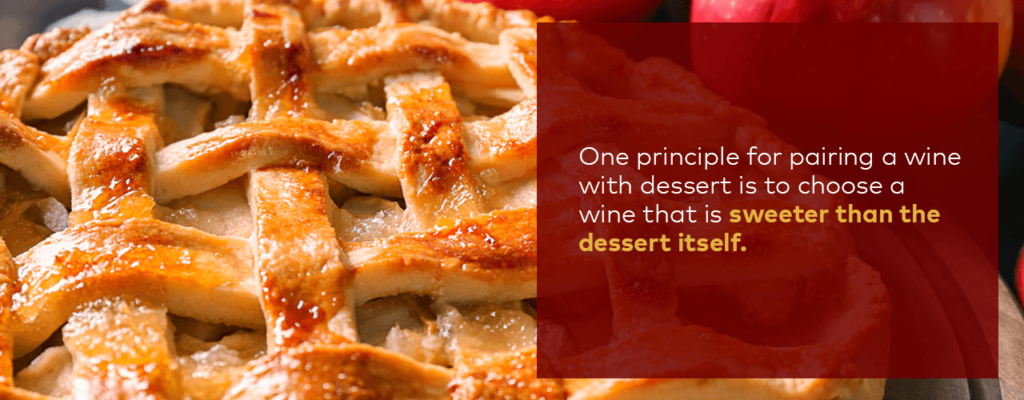
Fruity Desserts
Who doesn’t love a fruity dessert like apple pie or pear tart to cap off their meal? One principle for pairing a wine with dessert is to choose a wine that is sweeter than the dessert itself. Since fruity desserts are somewhat acidic, you also want to choose a wine that can match the acidity of the dessert. Some white wines that tend to work well are Chenin Blanc and late-harvest Gewurztraminer. Pink champagne is another solid choice for fruity desserts.
Chocolate Desserts
Chocolate desserts are beautifully rich and dark, so the wines that accompany them should be, too. One of the most traditional choices for a chocolate dessert is port, but other red wines like Grenache, Banyuls and late-harvest Pinot Noir, can also go beautifully with chocolate desserts. White wine tends to be too acidic to pair well with rich, chocolatey desserts, so stick to reds and enjoy the luxurious experience.
Creamy Desserts
Another dessert category to consider is creamy desserts, such as crème brûlée, custard pies or flan. These desserts tend to have a delicate, mild flavor and a pleasing smoothness, so the wines that accompany them should share these characteristics. Sweet whites, like Moscato and late-harvest Riesling, are excellent choices, as are sparkling wines like demi-sec champagne.

Food Pairing With Beer
Beer pairing isn’t as familiar a topic to most people as wine pairing, but beer and food go together, so why don’t we focus as heavily on creating the perfect pairings when it comes to beer? In recent years, beer pairing has become a more popular pursuit for beer enthusiasts, with some restaurants even focusing on offering craft beers as part of a food pairing menu.
When it comes to pairing the perfect beer with your meal, the same principles we’ve discussed so far still apply. In addition to these guiding principles, you may also want to consider aspects of your meal like its regional ties and whether it features any seasonal selections. This may steer you toward regional beers or seasonal beers to match your meal. Let’s look at the same common categories of food and what types of beers tend to work best.
Salad
A fresh green salad is crisp and light, so you don’t want to overpower it with a heavy beer. Remember, pairing often comes down to finding drinks that share similar descriptions to the food you’re planning for, so a light salad calls for a light beer. Golden or light lagers will do the trick here. As we mentioned with wine, though, consider the dressing and factor that into your choice. A heavy dressing may justify a heavier beer selection.
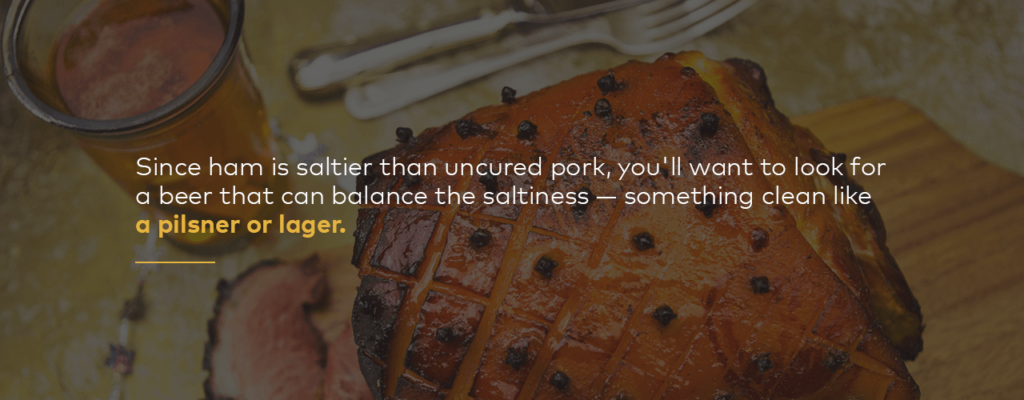
Pork
There are plenty of possibilities when you’re looking to pair beer with a pork dinner. For grilled tenderloin or chops, try a hefeweizen or a similarly malty, sweet beer. You also can’t go wrong with a classic stout. Since ham is saltier than uncured pork, you’ll want to look for a beer that can balance the saltiness — something clean like a pilsner or lager. However, if the ham is sweetened by a glaze, then you may want to opt for a wheat beer or dark ale that can help balance and highlight both the saltiness and sweetness.
Poultry
Beer pairs well with poultry, especially dark meat and fried chicken, since it can help lift the meal and clean the palate. Since poultry tends to be a milder meat, you’ll typically want to pair it with a mild beer like a light German lager or a blonde ale. If you’re serving up a rustic roast chicken dish, then you may want to pair it with a rustic beer such as an English bitter for a consistent theme. If your poultry dish is heavily seasoned, make sure you choose a beer that can match its intensity.
Beef and Lamb
If you’ve ever had beef stew flavored with dry stout, then you know just how delicious the combination of beef or lamb and dark beer can be. Just as robust reds are the go-to choice of wine for beef and lamb, when pairing beer with these meats, you want to look for bold, dark, hearty beers. Think brown ales, malty stouts and porters that won’t be overshadowed by the richness of the meat.
Fish
Since fish is generally lighter than other meats, you’ll typically want to opt for a more mild beer. Some examples include light lagers, amber ales and red ales. However, if your fish will be made heavier by a rich sauce or frying, then you may need to reach for a richer beer to match. Fried fish, in particular, is a meal that demands a delicious beer pairing. A bitter beer like an IPA or pale ale tends to pair well with fried fish since it can cut through the greasiness.
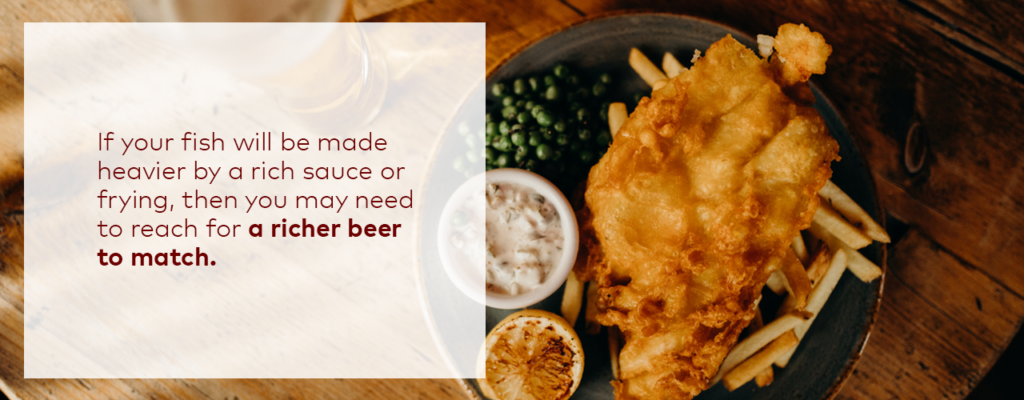
Shellfish
You may not typically see someone enjoying a beer with their lobster — though there are certainly people out there who enjoy beer with any meal — but beer is a great beverage for pairing with some shellfish, especially oysters. When enjoying oysters or cocktail shrimp with cocktail sauce, try a beer like an IPA that has some spicy characteristics of its own to bite back at the sauce. For dressed-down oysters, you’ll want a more delicate drink, such as a light cask ale or gueuze.
Cheese
Wine may hold the reputation for being the perfect companion to cheese, but many beer lovers will quickly point out that beer can offer just as perfect a pairing. Beer cheese alone is evidence that beer and cheese taste great together. When it comes to having beer with a cheesy meal, since beer is carbonated, it can help to lift an otherwise heavy dish like pizza. Just as a wide variety of wines pair well with cheese, beer and cheese pairings are nearly endless, as well. Look for a beer that matches the cheese’s level of intensity.
Spicy Dishes
Beer is an excellent beverage to pair with spicy dishes. Most people associate beer with some spicy foods like buffalo wings but may not think to pair beer with other spicy cuisines, such as Thai or Mexican. Spicy foods can be balanced by a light lager or IPA. The hops in the beer can help to soften the spiciness a bit. When you’re enjoying some spicy regional cuisine, try pairing it with a beer from that region for a cohesive and delicious experience.
Fruity Desserts
Tired of coffee or dessert wine with dessert? You can enjoy a delightful beer pairing with your dessert, including fruity desserts. The beer you choose should be sweeter than the dessert so that it doesn’t taste dry in comparison. For fruit desserts like a blackberry cobbler or apple crisp, look for a fruit beer or a yeasty beer that has some fruity notes. For example, dunkelweizens pair beautifully with rustic fruit-based desserts. If the dessert is nutty, try a nutty brown ale.
Chocolate Desserts
A chocolate cake can be the perfect way to end a meal, but you may wonder what beer to pair with something so intense in flavor. You want to match the dark intensity of chocolate by choosing a stout or porter. Just make sure it’s a sweet stout or porter. Dryer varieties won’t taste right with a dessert. If you would prefer a lighter option, you can try a light, fruity lager or ale, which can lift the intensity of the dessert and provide a bit of contrast.
Creamy Desserts
Since creamy desserts tend to be delicate and simplistic, it can be easy to overpower a creamy dessert or create an unpleasant contrast with the wrong beer. For creamy desserts like cheesecake, you need to find a beer that shares the same kind of creamy silkiness that characterizes the dessert. One delicious example is a silky oatmeal stout. This beer offers the perfect amount of warmth and silkiness to help round out your meal.
Enjoy Rich Flavors From S. Clyde Weaver to Pair With Your Favorite Drinks
At S. Clyde Weaver, we’re passionate about amazing tastes for every aspect of your meal. For delicious smoked meats, cheeses and other delicacies to enjoy with your favorite drinks, browse our selection and place an order today. With over a century in the business, we understand the importance of quality and time-honored methods of preparation. Whether you’re looking for the perfect cheeses to enjoy with your favorite wine or a savory ham to serve with your favorite lager, Weaver’s can help you create a delicious experience for you and your guests.






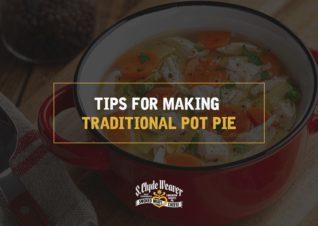
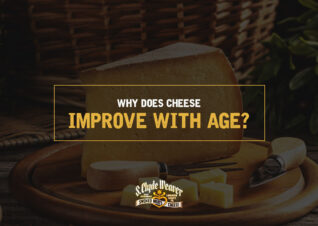



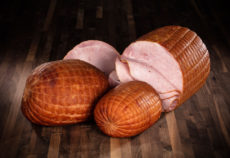

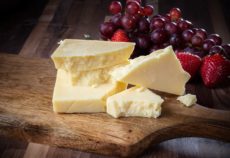
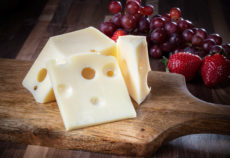
I would love to try all of these food pairing guides that you mention. Thank you also for sahring your thoughts on the principles of flavor pairing.